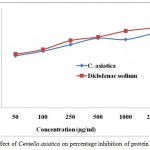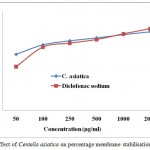Manuscript accepted on : April 20, 2011
Published online on: 28-06-2011
In vitro Anti-arthritic Activity of Methanolic Extract of Centella asiatica
Seema chaitanya Chippada, Sharan Volluri, Srinivasa rao Bammidi and Meena Vangalapati*
Centre of Biotechnology, Department of Chemical Engineering, A.U. College of Engineering (A), Andhra University, Visakhapatnam - 530 003 India.
Corresponding Author Email: meena_sekhar09@yahoo.co.in
ABSTRACT: Centella asiatica is a valuable medicinal herbaceous aromatic creeper which has been valued for centuries in ayurvedic medicine. Phytochemical analysis of Centella asiatica plant extracts revealed the presence of various biochemical compounds such as alkaloids, flavonoids, glycosides, triterpenoids and saponins etc. Our present work aims at evaluating the in-vitro anti-thritic effect of Centella asiatica at various concentrations. The inhibition of protein denaturation and membrane stabilisation were taken as a measure of the in vitro anti-arthritic activity. The maximum percentage inhibiton of protein denaturation and membrane stabilisation for C. asiatica extracts ware found to be 89.76 % and 94.97 % respectively at a dose of 2000 μg/ml. Therefore, our studies support the isolation and the use of active constituents from Centella asiatica in treating arthritis.
KEYWORDS: Anti-arthritic activity; Centella asiatica; Diclofenac sodium; Triterpenoids; Flavonoids
Download this article as:| Copy the following to cite this article: Chippada S. C, Volluri S, Bammidi S. R, Vangalapati M. In vitro Anti-arthritic Activity of Methanolic Extract of Centella asiatica. Biosci Biotech Res Asia 2011;8(1) |
| Copy the following to cite this URL: Chippada S. C, Volluri S, Bammidi S. R, Vangalapati M. In vitro Anti-arthritic Activity of Methanolic Extract of Centella asiatica. Biosci Biotech Res Asia 2011;8(1). Available from: https://www.biotech-asia.org/?p=9390 |
Introduction
Rheumatoid arthritis is a major ailment among rheumatic disorders. It is a chronic condition with multiple causation and affects the people in their most active period of life. The production of auto antigens in certain arthritic diseases may be due to in vivo denaturation of proteins1 and The mechanism of denaturation probably involves alteration in electrostatic, hydrogen, hydrophobic and disulphide bonding3. So, by controlling the production of auto antigen and inhibiting denaturation of protein and membrane lysis in rheumatic disease leads to anti-arthritic activity. Hence, inhibition of protein denaturation and membrane lysis were taken as a measure of the in vitro anti-arthritic activity. A larger number of herbal extracts are in vogue for the treatment of various types of arthritis.
Centella asiatica is a perennial creeper, faintly aromatic and a valuable medicinal herb of which is distributed throughout tropical and subtropical regions of World such as India, China, Nepal, Srilanka, Indonesia and Eastern South America10. Traditionally, C. asiatica has been valued for centuries in ayurvedic medicine for the treatment of leprosy, asthma, elephantiasis, eczemas, urethritis4, eye troubles, diarrhoea among children, skin diseases, wound healing11 and for revitalizing the nerves and brain cells, hence primarily known as a “Brain food” or “Memory enchancer” 7 in India. Phytochemical analysis of C. asiatica plant extracts revealed the presence of various biochemical compounds such as alkaloids2, flavonoids8, glycosides, triterpenoids, saponins, amino acids6, inorganic acids5, vitamins12, sterols and lipid compounds2, 9. Our present work aims at evaluating the anti-arthritic effect of Centella asiatica at various concentrations by using in-vitro pharmacological models.
Materials and Methods
Collection of Plant Material
The fresh whole plant of C. asiatica was collected from in and around the premises of Andhra University, City of Visakhapatnam, Andhra Pradesh, India. All the other chemicals and reagents were of pure analytical grade and obtained from local supplier.
Extraction and Preparation of Extract
The leaves were garbled and dried under shade and powdered. The 10 g of dried powdered leaves of the plant materials were extracted separately with methanol using soxhlet apparatus for 48 hrs. The solvent was distilled at lower temperature under reduced pressure and concentrated on water bath to get the crude extract which is stored in desiccator for future use. The % of yield is 13.37 % respectively.
Inhibition of Protein Denaturation
Test solution (0.5ml) consist of 0.45ml of Bovine serum albumin (5%W/V aqueous solution) and 0 .05ml of test solution.
Test control solution (0.5ml) consist of 0.45ml of bovine serum albumin (5%W/V aqueous solution) and 0 .05ml of distilled water.
Product control (0.5ml) consists of 0.45ml of distilled water and 0.05 ml of test solution.
Standard solution (0.5ml) consists of 0.45ml of Bovine serum albumin (5%w/v aqueous solution) and 0.05ml 0f Diclofenac sodium.
Various concentrations (50, 100, 250, 500, 1000, 2000 μg/ml) of plant extracts (test solution) and diclofenac sodium (standard) of were taken respectively. All the above solutions were adjusted to pH 6.3 using 1N HCl. The samples were incubated at 37°c for 20 minutes and the temperature was increased to keep the samples at 57°c for 3 minutes. After cooling, add 2.5 ml of phosphate buffer to the above solutions. The absorbance was measured using UV-Visible spectrophotometer at 416nm.
The control represents 100% protein denaturation. The results were compared with Diclofenac sodium. The percentage inhibition of protein denaturation of different concentrations was tabulated in Table.1 & Fig. 1.
Table 1: Effect of Centella asiatica and standard on inhibition of protein denaturation and membrane stabilisation.
| Conc. | % Inhibition of | % Inhibition of | % Stabilisation of | % Stabilisation of |
| (μg/ml) | C. asiatica | Diclofenac | C. asiatica | Diclofenac |
| sodium | sodium | |||
| 50 | 62.74 | 64.81 | 67.74 | 52.81 |
| 100 | 68.29 | 70.54 | 79.22 | 76.54 |
| 250 | 76.25 | 81.32 | 84.05 | 81.32 |
| 500 | 84.02 | 85.67 | 87.56 | 85.67 |
| 1000 | 82.43 | 92.78 | 91.54 | 92.58 |
| 2000 | 89.76 | 96.52 | 94.97 | 98.76 |
 |
Figure 1: Effect of Centella asiatica on percentage inhibition of protein denaturation
|
The percentage inhibition of protein denaturation can be calculated as,
Percentage Inhibition = [100 – (Optical Denity Of Test Solution – Optical Density Of Product Control) ÷ (Optical Density Of Test Control) × 100.
Effect on membrane stabilisation / Inhibition of membrane lysis
The principle involved here is stabilization of human red blood cell (HRBC) membrane by hypo tonicity induced membrane lysis. The assay mixture contains 1ml phosphate buffer [pH 7.4, 0.15 M], 2 ml hypo saline [0.36 %], 0.5 ml HRBC suspension [10 % v/v] with 0.5 ml of plant extracts and standard drug diclofenac sodium of various concentrations (50, 100, 250, 500, 1000, 2000 μg/ml) and control (distilled water instead of hypo saline to produce 100 % hemolysis) were incubated at 37oC for 30 min and centrifuged respectively. The hemoglobin content in the suspension was estimated using spectrophotometer at 560 nm. The percentage of membrane stabilisation at different concentrations was tabulated in Table.1 & Fig. 2
 |
Figure 2: Effect of Centella asiatica on percentage membrane stabilisation / protection.
|
The percentage inhibition of membrane stabilisation can be calculated as,
Percentage Inhibition = 100 – [(Optical Denity Of Test Solution) ÷ (Optical Density Of Control) × 100].
Results and Discussions
The methanolic extracts of Centella asiatica has showed significant activity at various concentrations and its effect was compared with the standard drug Diclofenac sodium. The maximum percentage inhibition of protein denaturation and membrane stabilisation was observed as 89.76% and 94.97 % at 2000 μg/ml respectively as shown in Table. 1. The production of auto antigen in certain arthritic disease may be due to denaturation of protein and membrane lysis. From the results (Fig. 1 & 2) of our present study, it can be stated that methanol extracts are capable of controlling the production of auto antigen and inhibits denaturation of protein and membrane lysis in rheumatic disease.
Conclusion
Inhibition of protein denaturation and membrane stabilisation was studied to establish the mechanism of anti‐arthritic effect of C. asiatica. Therefore, our present in-vitro studies on C. asiatica extracts demonstrate the significant anti-arthritic activity. Due to the presence of active principles such as flavonoids and tritrepenoids (asiaticoside, madecassoside etc) and related polyphenols may responsible for this activity. Hence, C.asiatica can be used as a potent anti-arthritic agent.
References
- Brown JH, Mackey HK., Inhibition of heat-induced denaturation of serum proteins by mixtures of non-steroidal anti-inflammatory agents and amino acids, Proc Soc Exp Biol Med ., 128, 225-228, (1968).
- Chopra R. N., Nayar S. L. and Chopra I. C., Glossary of Indian Medicinal Plants, (Council for Scientific and Industrial Research, New Delhi), pp. 58, (1956).
- Grant NH, Alburn HE, Kryzanauskas C., Stabilisation of serum albumin by anti-inflammatory drugs. Biochem Pharmacol., 19, 715-22, (1970).
- Kakkar KK., Mandukaparni-medicinal uses and therapeutic efficacy, Indian Drugs., 26, 92-97, (1988).
- Kapoor L. D., CRC Handbook of Ayurvedic Medicinal Plants, (CRC Press LLC, Florida), 208-209, (2005).
- Malhotra C. L., Das P. K., Sastry M. S. and Dhalla N. S., Chemical and pharmacological studies on Hydrocotyle asiatica Linn., Indian J Pharm., 23, pp. 06, (1961).
- Nalini K., Aroor AR, Karanth K. S. and Rao A., Effect of Centella asiatica fresh leaf aqueous extract on learning memory and biogenic amine turnover in albino rats, Fitoterapia., 63, 232-237, (1992).
- Rastogi R. P. and Mehrotra B. N., Compedium of Indian Medicinal Plants, (Central Drug Institute Lucknow and Publication and Information Directorate, CSIR, New Delhi), 1, pp. 96. (1963).
- Srivastava R., Shukla Y. N., Kumar S.., Chemistry and pharmacology of the Centella asiatica – A Review. J Med Arom Pl Sci., 19, 1049-1057, (1997).
- Subban Ravi, Veerakumar A., Manimaran R.., Hashim K. M., Balachandra Indira., Two new flavonoids from Centella asiatica (Linn.), J Nat Med., 62, 369-373, (2008).
- Suguna L., Sivakumar P. and Chandrakasan G., Effect of Centella asiatica extract on dermal wound healing in rats, Indian J. Exp. Biol., 34, 1208-1211, (1996).
- Tiwari Nath Kavindra, Sharma Chandra Nilesh, Tiwari Vaibhav and Singh Deo Brahma., Micropropagation of Centella asiatica (L.), a valuable medicinal herb, Plant Cell, Tissue and Organ Culture, 63, 179-185, (2000).

This work is licensed under a Creative Commons Attribution 4.0 International License.





